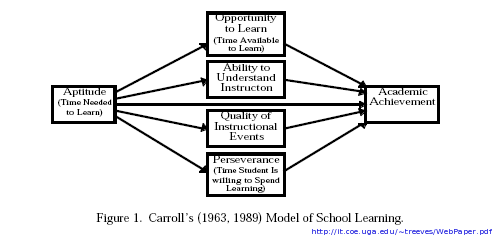Carroll model of school learning
 From EduTechWiki - Reading time: 2 min
From EduTechWiki - Reading time: 2 min
Definition[edit | edit source]
- In 1993, John Carroll proposed a model for school learning. Learning was defined as function of efforts spent in relation to efforts needed. Most of the model is time based.
- According to Huitt ([1]): School Learning = f(time spent/time needed). (DSchneider believes that this definition does not capture the full model).
The Model[edit | edit source]
According to Reeves (1997) Carroll's model include six elements with one output variable, one input variable and 4 intermediate variables.
- Academic Achievement is the output (as measured by various sorts standard achievement tests)
- Aptitude is the main explanatory variable defined as the "the amount of time a student needs to learn a given task, unit of instruction, or curriculum to an acceptable criterion of mastery under optimal conditions of instruction and student motivation" (Carroll, 1989: 26). This definition of aptitude very much reminds the principle behind mastery learning. "High aptitude is indicated when a student needs a relatively small amount of time to learn, low aptitude is indicated when a student needs much more than average time to learn" (Carrol: 1989: 26).
- Opportunity to learn: Amount of time available for learning both in class and within homework. Carroll (1998:26) notes that "frequently, opportunity to learn is less than required in view of the students aptitude.
- Ability to understand instruction: relates to learning skills, information needed to understand, and language comprehension.
- Quality of instruction: good instructional design, e.g. like it is usually defined in behaviorist frameworks like nine events of instruction. If quality of instruction is bad, time needed will increase.
- Perseverance: Amount of time a student is willing to spend on a given task or unit of instruction. This is an operational and measurable definition for motivation for learning.
Time needed to learn and quality of instruction[edit | edit source]
The most important question the Carroll model (and numerous follow-up studies) raises is: What is appropriate time needed to learn (TTL) ?
“The model of school learning assumes that students differ in the amount of learning time they need. If these differences are to be adequately taken account of, considerable skill in classroom management is required of teachers” (Carroll 1989: 29).
See also the instructional time article.
Carrol's model differs from Bloom's by seeking equality of "opportunity", not necessarily equality of attainment. “Emphasizing equality of opportunity means not only providing appropriate opportunities to learn (appropriate, not necessarily equal for all students), but also pushing all student's potentialities as far as possible toward their upper limits.” (Carroll 1989:30). According to Carroll, good planning is a key factor, but also good instructional design.
Links[edit | edit source]
- Huitt, Overview of Classroom Processes / Carroll's Model of School Learning, HTML (retrieved 17:24, 23 May 2006 (MEST)).
References[edit | edit source]
- Berliner, David, C. (1990). What's All the Fuss About Instructional Time? HTML. From: The Nature of Time in Schools Theoretical Concepts, Practitioner Perceptions (1990).
New York and London: Teachers College Press; Teachers College, Columbia University;
- Carroll, J. B. (1968). On learning from being told. Educational Psychologist, 5, 4-10.
- Carroll, J. B. (1963). A model of school learning. Teachers College Record, 64, 723-733.
- Carroll, J. B. (1989), The Carroll Model: A 25-Year Retrospective and Prospective View, Educational Researcher, 18 (1) 26-31. HTML (restricted access).
- Reeves, TC, & Reeves, PM (1997). A model of the effective dimensions of interactive learning on the World Wide Web. PDF. (This paper provides a good introduction to the Carroll Model and adds its own model of WWW-based learning).
 KSF
KSF